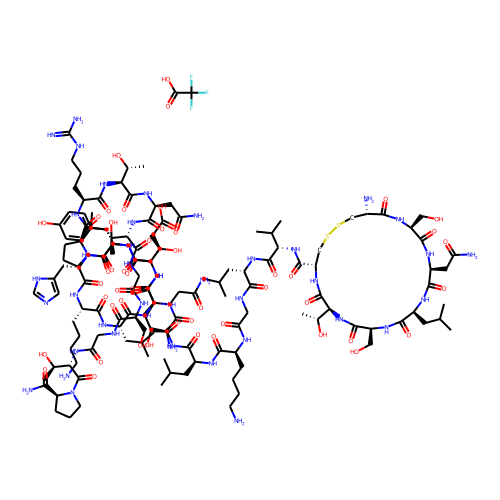Calcitonin (salmon) (trifluoroacetate salt)
| Code | Size | Price |
|---|
| TAR-T37413-1mg | 1mg | £192.00 | |||||||||||||||||||||||||||||||||||||||||||||||||||||||||||||||||||||||||||||||||||||||||||||||||
| Special offer! Add £1 to your order to get a TargetMol CCK-8 Kit. Read more here. | |||||||||||||||||||||||||||||||||||||||||||||||||||||||||||||||||||||||||||||||||||||||||||||||||||
Quantity:
Prices exclude any Taxes / VAT
Overview
Regulatory Status: RUO
Shipping:
cool pack
Storage:
-20℃
Images
Documents
Further Information
Bioactivity:
Calcitonin is a peptide hormone that lowers blood calcium level and inhibits bone resorption. It belongs to the calcitonin family of peptides, which also includes amylin , calcitonin gene-related peptide , and adrenomedullin. The binding of salmon calcitonin to the human calcitonin receptor (CTR) is not modulated by receptor activity-modifying proteins (RAMPs), which influence affinity of human calcitonin to CTR. Salmon calcitonin binds to human CTR2 with IC50 values of 0.933, 0.224, 0.134, and 0.317 nM alone and with RAMP1, 2, or 3, respectively. It induces cAMP accumulation in COS-7 cells transfected with CTR2 (EC50 = 0.166 nM). Salmon calcitonin inhibits bone resorption by osteoclasts in a pit formation assay using rat bone slices (ID50 = 0.003 pg/mL) and lowers calcium level in vivo in a bioassay of hypocalcemia in rats (ED15 = 33.9 mg/kg). Formulations containing salmon calcitonin have been used to treat hypercalcemia, bone destruction by osteoporosis, and Paget's disease.
CAS:
171052-37-2
Formula:
C147H241F3N44O50S2
Molecular Weight:
3545.92
Purity:
0.98
SMILES:
OC(=O)C(F)(F)F.CC(C)C[C@H](NC(=O)[C@@H](NC(=O)[C@@H]1CSSC[C@H](N)C(=O)N[C@@H](CO)C(=O)N[C@@H](CC(N)=O)C(=O)N[C@@H](CC(C)C)C(=O)N[C@@H](CO)C(=O)N[C@@H]([C@@H](C)O)C(=O)N1)C(C)C)C(=O)NCC(=O)N[C@@H](CCCCN)C(=O)N[C@@H](CC(C)C)C(=O)N[C@@H](CO)C(=O)N[C@@H](CCC(N)=O)C(=O)N[C@@H](CCC(O)=O)C(=O)N[C@@H](CC(C)C)C(=O)N[C@@H](Cc1cnc[nH]1)C(=O)N[C@@H](CCCCN)C(=O)N[C@@H](CC(C)C)C(=O)N[C@@H](CCC(N)=O)C(=O)N[C@@H]([C@@H](C)O)C(=O)N[C@@H](Cc1ccc(O)cc1)C(=O)N1CCC[C@H]1C(=O)N[C@@H](CCCNC(N)=N)C(=O)N[C@@H]([C@@H](C)O)C(=O)N[C@@H](CC(N)=O)C(=O)N[C@@H]([C@@H](C)O)C(=O)NCC(=O)N[C@@H](CO)C(=O)NCC(=O)N[C@@H]([C@@H](C)O)C(=O)N1CCC[C@H]1C(N)=O



